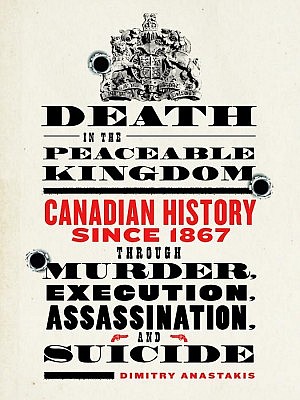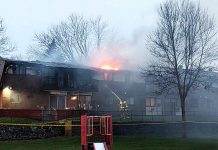
Dimitry Anastakis is a professor of history at Trent University in Peterborough.
He is the author and editor or co-editor of eight books and collections, including Death in the Peaceable Kingdom: Canadian History since Confederation through Murder, Execution, Assassination and Suicide (2015), Smart Globalization: The Canadian Business and Economic History Experience (2014), Autonomous State: The Struggle for a Canadian Car Industry (2013), Framing Canadian Federalism: Essays in Honour of John T. Saywell (2009), The Sixties: Passion, Politics and Style (2006), and Auto Pact: Creating a Borderless North American Auto Industry (2005).
Professor Anastakis has appeared and been quoted in the media extensively, including CTV, CBC, TVO, BNN and numerous newspapers, and his research has been discussed in the National Post and The New York Times.
Professor Anastakis has also published articles in The Walrus, The Globe and Mail, the Toronto Star, the National Post, The Guardian online, the Literary Review of Canada, and The American Prospect online.
In Death in the Peaceable Kingdom: Canadian History since Confederation through Murder, Execution, Assassination and Suicide, Professor Anastakis brings Canadian history to life using the “hooks” of murder, execution, assassination, and suicide. Scattered throughout the book are short vignettes — “Murderous Moments” and “Tragic Tales” — designed to keep readers engaged and entertained while they learn. The book was influenced and inspired by a course of the same name he teaches at Trent — Professor Anastakis’ students even shared comments on sample chapters and voted on the book’s cover.
Death in the Peaceable Kingdom is available from University of Toronto Press and Amazon.ca.
Excerpts from Death in the Peaceable Kingdom: Canadian History since 1867 through Murder, Execution, Assassination and Suicide (University of Toronto Press, 2015)
Part One: Our Violent, Bloody Confederation

The tale of Canada’s emergence is not for the faint of heart. Creating the nation was a challenging, titanic, often brutish, and thoroughly violent affair — the country itself emerged from a maelstrom of terrorism and invasion, and the early Confederation period witnessed no less than one uprising, one outright rebellion, the assassination of two Fathers of Confederation, and the execution of another.
All of these events are intimately linked, as they form the core elements that help to explain how, when, and why Confederation appeared as it did. Shaping the idea of a new nation-state into a reality in the northern half of North America, albeit a state that was still closely tied to its British mother country, was not solely an act of imagination, nor simply a bloodless legal transaction. To understand the early Canadian political, economic, and social landscape is to recognize that the country’s birth and first years were marked by violence and to comprehend the undeniable fragility of the young nation, a fragility seemingly threatened at nearly every turn.
Murderous Moment: Patrick James Whelan, Executed, Ottawa, 1869
Justice Delivered or Racial Profiling and sham Trials in an Earlier Era of Terror?
What happened to D’Arcy McGee’s alleged assassin, Patrick James Whelan? McGee, an enemy of the Fenians, had been killed on Sparks Street after giving a speech in the House of Commons. Unsurprisingly, many people immediately suspected that the assassin was a Fenian. Remember, 1868 was in the midst of the Fenian attacks, and, in this fearful atmosphere, just about anyone sympathetic to the cause of Irish nationalism was suspected of being a potential Fenian.
After McGee’s assassination, the Ottawa police embarked on a massive manhunt, fuelled by a $2,000 dollar reward offered by Ottawa Mayor Henry J. Friel for the capture of McGee’s killer. Within two days, Patrick James Whelan was arrested for the murder (along with dozens of other suspected Fenians). His name had been given to police by one of John A. Macdonald’s spies. The police tracked Whelan down to his hotel and found with him a Fenian newspaper and a revolver, which, the police stated, had been fired within the last 48 hours. Whelan himself fit the profile of McGee’s suspected killer. Born in Dublin, he was 28 years old, having come to Canada in 1865. He was known as a Fenian sympathizer, and, he was in the wrong place at the wrong time.
Chapter Five – Private Harold Carter, Executed, France, 1917: The Tragedy and Heroism of the First World War, 1914-18
The glory of war and the sadness of war. We are all familiar with the glory of war. It comes down to us through the generations, venerating, celebrating, holding in highest respect those who fought, and those who died. We know poems such as “In Flanders Fields,” and we know what they are supposed to mean to us. We know the heroes such as John McCrae, who wrote the poem and is rightfully famous. McCrea was a doctor from Guelph who served at the front and who died at the front, but whose haunting poetry remains an indelible part of the war and of the memory that is passed down to us of that war. “In Flanders Fields” is recited in Canadian grade schools and during Remembrance Day ceremonies in Canada, the United Kingdom, and Australia. It has even been imprinted on our 10-dollar bill. The poem’s presence in our collective memory a century after it was first written is a testament to its haunting words — and to the impact of the Great War on Canadian society.
But there is often another side of the story. The side of war that is not glorious, or triumphant, or celebrated in stories or in poems. There is the forgotten horror of war, as much as there is the glory of it.
One such story is that of Private Harold George Carter.
Murderous Moment: Paul Joseph Chartier, Killed While Attempting to Blow up the House of Commons, 1966
A Little-Known Attack on Canada’s Seat of Government
The 1960s were a period of profound change and dislocation. Social, cultural, and political revolution was in the air, and, in some instances, violence, which often lasted into the 1970s, accompanied these calls for change. From the FLQ in Quebec, to the Weather Underground in the United States, the Red Brigades in Europe, and revolutionary uprisings in South America, the world seemed aflame with militant and sometimes violent demands for change that could not be contained within the established political process. Most of the violence in this period emerged from organizations and movements whose causes were rooted in legitimate grievances; they would say that their violent tactics were necessary, though many would disagree.
In other instances, the violence that erupted in the 1960s (and at other times in Canadian history) had little rhyme or reason. People acting alone have at times sought to use violence as a means of expressing their own personal complaints or problems, as a way to highlight some particular grievance or because they are suffering mental illness.
One such person was Paul Joseph Chartier.


























